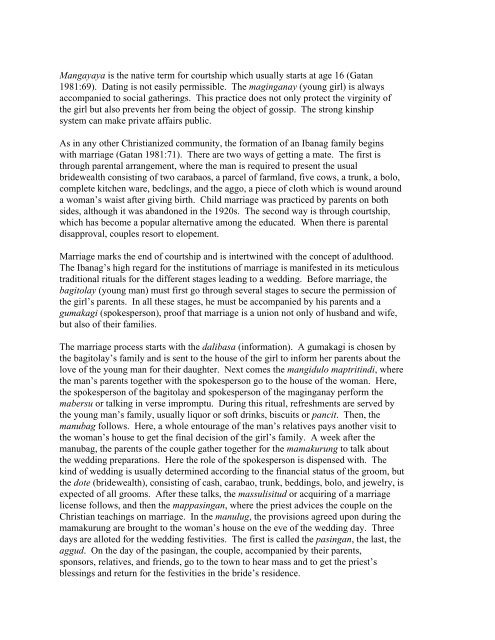The word “Ibanag” derives from the prefix “i” meaning ... - Buffalo
The word “Ibanag” derives from the prefix “i” meaning ... - Buffalo
The word “Ibanag” derives from the prefix “i” meaning ... - Buffalo
Create successful ePaper yourself
Turn your PDF publications into a flip-book with our unique Google optimized e-Paper software.
Mangayaya is <strong>the</strong> native term for courtship which usually starts at age 16 (Gatan<br />
1981:69). Dating is not easily permissible. <strong>The</strong> maginganay (young girl) is always<br />
accompanied to social ga<strong>the</strong>rings. This practice does not only protect <strong>the</strong> virginity of<br />
<strong>the</strong> girl but also prevents her <strong>from</strong> being <strong>the</strong> object of gossip. <strong>The</strong> strong kinship<br />
system can make private affairs public.<br />
As in any o<strong>the</strong>r Christianized community, <strong>the</strong> formation of an Ibanag family begins<br />
with marriage (Gatan 1981:71). <strong>The</strong>re are two ways of getting a mate. <strong>The</strong> first is<br />
through parental arrangement, where <strong>the</strong> man is required to present <strong>the</strong> usual<br />
bridewealth consisting of two carabaos, a parcel of farmland, five cows, a trunk, a bolo,<br />
complete kitchen ware, bedclings, and <strong>the</strong> aggo, a piece of cloth which is wound around<br />
a woman’s waist after giving birth. Child marriage was practiced by parents on both<br />
sides, although it was abandoned in <strong>the</strong> 1920s. <strong>The</strong> second way is through courtship,<br />
which has become a popular alternative among <strong>the</strong> educated. When <strong>the</strong>re is parental<br />
disapproval, couples resort to elopement.<br />
Marriage marks <strong>the</strong> end of courtship and is intertwined with <strong>the</strong> concept of adulthood.<br />
<strong>The</strong> Ibanag’s high regard for <strong>the</strong> institutions of marriage is manifested in its meticulous<br />
traditional rituals for <strong>the</strong> different stages leading to a wedding. Before marriage, <strong>the</strong><br />
bagitolay (young man) must first go through several stages to secure <strong>the</strong> permission of<br />
<strong>the</strong> girl’s parents. In all <strong>the</strong>se stages, he must be accompanied by his parents and a<br />
gumakagi (spokesperson), proof that marriage is a union not only of husband and wife,<br />
but also of <strong>the</strong>ir families.<br />
<strong>The</strong> marriage process starts with <strong>the</strong> dalibasa (information). A gumakagi is chosen by<br />
<strong>the</strong> bagitolay’s family and is sent to <strong>the</strong> house of <strong>the</strong> girl to inform her parents about <strong>the</strong><br />
love of <strong>the</strong> young man for <strong>the</strong>ir daughter. Next comes <strong>the</strong> mangidulo maptritindi, where<br />
<strong>the</strong> man’s parents toge<strong>the</strong>r with <strong>the</strong> spokesperson go to <strong>the</strong> house of <strong>the</strong> woman. Here,<br />
<strong>the</strong> spokesperson of <strong>the</strong> bagitolay and spokesperson of <strong>the</strong> maginganay perform <strong>the</strong><br />
mabersu or talking in verse impromptu. During this ritual, refreshments are served by<br />
<strong>the</strong> young man’s family, usually liquor or soft drinks, biscuits or pancit. <strong>The</strong>n, <strong>the</strong><br />
manubag follows. Here, a whole entourage of <strong>the</strong> man’s relatives pays ano<strong>the</strong>r visit to<br />
<strong>the</strong> woman’s house to get <strong>the</strong> final decision of <strong>the</strong> girl’s family. A week after <strong>the</strong><br />
manubag, <strong>the</strong> parents of <strong>the</strong> couple ga<strong>the</strong>r toge<strong>the</strong>r for <strong>the</strong> mamakurung to talk about<br />
<strong>the</strong> wedding preparations. Here <strong>the</strong> role of <strong>the</strong> spokesperson is dispensed with. <strong>The</strong><br />
kind of wedding is usually determined according to <strong>the</strong> financial status of <strong>the</strong> groom, but<br />
<strong>the</strong> dote (bridewealth), consisting of cash, carabao, trunk, beddings, bolo, and jewelry, is<br />
expected of all grooms. After <strong>the</strong>se talks, <strong>the</strong> massulisitud or acquiring of a marriage<br />
license follows, and <strong>the</strong>n <strong>the</strong> mappasingan, where <strong>the</strong> priest advices <strong>the</strong> couple on <strong>the</strong><br />
Christian teachings on marriage. In <strong>the</strong> manulug, <strong>the</strong> provisions agreed upon during <strong>the</strong><br />
mamakurung are brought to <strong>the</strong> woman’s house on <strong>the</strong> eve of <strong>the</strong> wedding day. Three<br />
days are alloted for <strong>the</strong> wedding festivities. <strong>The</strong> first is called <strong>the</strong> pasingan, <strong>the</strong> last, <strong>the</strong><br />
aggud. On <strong>the</strong> day of <strong>the</strong> pasingan, <strong>the</strong> couple, accompanied by <strong>the</strong>ir parents,<br />
sponsors, relatives, and friends, go to <strong>the</strong> town to hear mass and to get <strong>the</strong> priest’s<br />
blessings and return for <strong>the</strong> festivities in <strong>the</strong> bride’s residence.
















